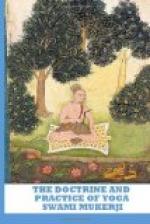Exercise 3.
Fill a wine glass full of water and taking the glass between the fingers, extend arm directly in front of you. Fix your eyes upon the glass and endeavour to hold your arm so steady that no quiver will be noticeable. Commence with one minute exercise and increase until the 5 minutes limit is reached. Alternate right and left arms. Increase to 15 minutes.
Exercise 4.
Sit erect in your chair, with your head up, chin out and shoulders back. Raise your right arm until it is level with your shoulders, pointing to the right. Turn your head and fix your gaze on your hand and hold the arm perfectly steady for one minute. Repeat with left arm. Increase the time gradually to 5 minutes. The palms of the hands should be turned downwards.
The following exercises are meant to aid you in getting under control, such mental faculties will produce voluntary movements.
Exercise 5.
Sit in front of a table, placing your hands upon the table, the fists clinched and lying with the back of the hand upon the table, the thumb being doubled over the fingers. Fix your gaze upon the fist for awhile and then slowly extend the thumb, keeping your whole attention fixed upon the act, just as if it was of the greatest importance. Then slowly extend your first finger, then your second and so on, until they are all open and extended. Then reverse the process, closing first the little finger and continuing the closing until the fist is again in its original position, with the thumb closed over the fingers. Repeat with left hand. Continue this exercise 5 times at a sitting, then increase to 10 times. Don’t forget to keep your attention closely fixed upon the finger movements. That is the main point.
Exercise 6.
Place the fingers of one hand between the fingers of the other, leaving the thumbs free. Then slowly twirl the thumbs one over the other, with a circular motion. Be sure to keep the attention firmly fixed upon the end of the thumbs.




